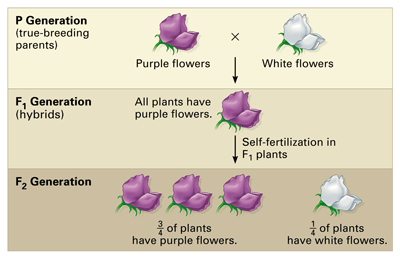CBSE Class 12 Biology Chapter 5 Revision Notes Part 1
Chapter 5: Principle of Inheritance and Variation Revision Notes Part 1
Inheritance refers to how characteristics are transferred from the parent to the offspring. In order to understand the process of inheritance, it is important to understand Mendel’s laws of inheritance.
Mendel’s laws of Inheritance
Mendel had experimented on a pea plant, considering 7 main contrasting traits in the plants to determine the principles of inheritance. The experiments led to the creation of Mendel’s laws which are known as principles of inheritance:
-
Law of Dominance: This was Mendel’s first principle of inheritance. As per the law of dominance, the hybrid offspring inherits only dominant traits. The recessive alleles that are the not dominant ones are suppressed. The dominant alleles are known as dormant alleles since they dictate the traits in the offspring.
-
Law of Segregation: As per the law of segregation, during the production of gametes, each of the two copies of the hereditary factor segregates so that the offspring acquires one factor from each parent. In other words, the allele pairs segregate during gamete formation and re-unite randomly during fertilization.
-
Law of Independent Assortment: Mendels’s second law of inheritance states that the traits segregate independently of other pairs during the process of gamete formation, or meiosis. Since the traits assort randomly, it is given that all the traits get an equal opportunity to occur together or have an equal probability to occur together.
-
The principle of paired factors: The principle of paired factors refers to the fact that two factors represent everyone. The two factors are on the two homologous chromosomes at the same locus. They each represent the expression of the same characteristic.
Amongst these laws, the law of segregation is universally accepted, while the others are not. It is the only law without any exceptions at all.
Inheritance of One Gene
In one of the hybridization experiments carried out by Mendel wherein he had crossed the tall and dwarf pea plants to study the inheritance of a single gene, he found that the F1 generation (the first generation of offspring) always resembled just one of the parents and that the specified trait of the other parent was not seen in them. However, he found that in the F2 generation, some of the offspring were ‘dwarfs.’ This ‘dwarf’ trait is known as the recessive trait.
From the observation, it was noted that the recessive parental trait is expressed without any blending in the F2 generation. This permits us to infer that when the tall and dwarf plant produces gametes through the process of meiosis, the alleles of the parental pairs separate, and only one allele is transmitted to a gamete.
Inheritance of Two Genes
Mendel also crossed pea plants that differed in two characters. He decided to carry out a cross between a pea plant that had seeds of yellow color and round shape and one that had seeds of green color and a wrinkled shape. It was uncovered then that the seeds resulting from the parents’ crossing had yellow and round seeds. Thus, it is easy to tell that yellow is the dominant trait, whereas green is recessive.
Similarly, the round shape is the dominant trait, and the wrinkled shape is a recessive trait. These results were identical to those that he got when he made separate monohybrid crosses between yellow and green seeded plants and between round and wrinkled seeded plants.
Sources:
Principles of inheritance and variation https://ncert.nic.in/textbook/pdf/lebo105.pdf. Accessed on 29 Dec, 2021
]]>


